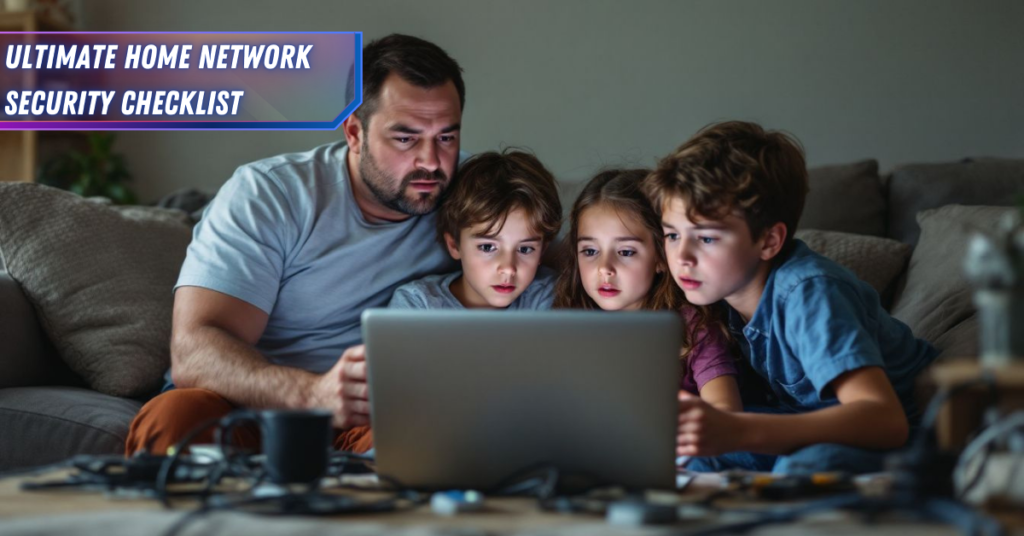Listen up, teens! After spending 15 years in the classroom watching how you navigate the digital world, I’ve got some real talk about internet safety. Here’s the shocking truth: 74% of teens have faced online risks, but only half of them tell anyone about it. Let’s cut through the usual boring advice and get to what you really need to know in this internet safety for teens guide.
Key Takeaways
- Your digital footprint is permanent – anything posted online can resurface years later and impact future opportunities.
- Public Wi-Fi is never secure – avoid logging into sensitive accounts or sharing personal information when using free networks.
- Strong passwords and two-factor authentication are your first line of defense – create unique combinations and never reuse passwords across accounts.
- Trust your gut on social media – if a message, friend request, or offer seems suspicious, it probably is.
- Cyberbullying requires immediate action – document everything, report it, and tell a trusted adult.
- Personal information is like currency – once shared online, you can’t take it back, so guard details like your address, full name, and school information carefully.
The Real Deal About Online Threats
Let me paint you a picture from my classroom last week. Jenny (not her real name) got this super convincing Instagram DM about “modeling opportunities” – complete with a legit-looking website and everything. Thankfully, she showed it to me before sending any personal info. This is exactly the kind of sophisticated scam you’re up against today.
The biggest threats you’re facing aren’t what you think. Sure, there’s the obvious stuff like viruses and sketchy downloads, but here’s what’s really going down:
- Social Engineering Scams: These are getting crazy sophisticated. Scammers study your social media and pretend to be someone you know. One of my students nearly sent $200 to someone posing as their best friend!
- Cyberstalking: About 26.5% of American teens have experienced this. Girls, you’re particularly vulnerable (28.6% compared to 24.2% of guys).
- Data Harvesting: Those fun personality quizzes? They’re collecting your personal info faster than you collect TikTok followers.
- Ransomware: Yep, even teens are targets. One of my students lost all their college application essays to this nightmare.
- Gaming Scams: Those “free” gaming offers are the digital equivalent of candy from strangers. Scammers target gamers through fake cheat codes, phony in-game currency generators, and bogus tournament sites. One of my students clicked a “free Robux” link and ended up with malware that hijacked their parent’s credit card info.
- Social Media Traps: Social media scams are like quicksand – they look harmless on the surface but can drag you down fast. Fake brand giveaways, verification badge scams, and too-good-to-be-true job offers flood platforms like Instagram and TikTok. These scams typically ask for personal information or small “processing fees” before disappearing with your data and money.
- Text and Email Tricks: Think of suspicious texts and emails like digital stranger danger. Scammers masquerade as legitimate companies, sending urgent messages about locked accounts or package deliveries. They create a false sense of urgency to make you click malicious links or share personal information. Remember: legitimate companies never ask for sensitive details via text or email.

Password Power and Privacy Basics
“But Mr. J, nobody’s gonna hack my accounts!” That’s what Alex said right before someone got into his Instagram and started messaging his entire friend list asking for money. Here’s the real deal about passwords and privacy:
Creating Unbreakable Passwords:
- Ditch the obvious: Your pet’s name + birthday = hacker’s paradise
- Use this formula: [Favorite song lyric] + [Random number] + [Special character]
- Example: Purple_Rain_1999! (but please don’t use this exact one!)
Privacy Settings That Actually Matter:
- Location services: Turn them OFF unless you’re actively using maps
- App permissions: Why does that flashlight app need access to your contacts? 🤔
- Two-factor authentication: Yes, it’s annoying. Yes, you absolutely need it.
Protecting Your Personal Information:
Think of your personal information like cash – you wouldn’t just hand it out to strangers on the street, right? As a technology teacher, I’ve seen too many teens accidentally overshare online, and trust me, the consequences can be serious.
Here’s the cold, hard truth: once your personal information is out there, it’s nearly impossible to take it back. Last semester, one of my students shared their phone number in a gaming chat. Within days, they were getting bombarded with spam calls and phishing attempts. Not fun!
The Never-Share List:
- Full name (use a nickname or first name only)
- Home address (including your neighborhood or nearby landmarks)
- School details (name, location, sports teams)
- Phone numbers (even “temporary” sharing can lead to problems)
- Social security numbers (NEVER share these – no legitimate site will ask)
Pro Tip: Create an information sharing checklist. Before posting anything online, ask yourself: “Could someone use this to find me in real life?” If the answer is yes, don’t share it!
Remember: Identity thieves are like digital detectives – they can piece together your personal info from tiny bits of data you leave across different platforms. Stay smart, stay safe, and keep your personal details under lock and key!
Social Media Smarts – More Than Just Selfies
Real talk: I’ve seen too many students learn the hard way that what goes online stays online forever. Last year, a senior lost their dream college acceptance because of an inappropriate tweet from freshman year. Let’s prevent that from happening to you.
The New Rules of Social Media:
- Think Future You: Before posting, ask: “Would I want my future boss/college admissions officer to see this?”
- Location Sharing: Those Snapchat maps showing your exact location? Stalker’s dream. Turn them off.
- Friend Requests: If you don’t know them IRL, don’t add them. Period.
- Digital Footprint Management: Google yourself monthly. Yes, really.

Cyberbullying – When Things Get Ugly
Cyberbullying remains one of the most prevalent threats, with nearly half of US teens reporting some form of online harassment.
I’m going to be real with you – cyberbullying has become more sophisticated than just mean comments. It’s morphed into something more sinister, including:
- Exclusion from online groups
- Spreading fake screenshots
- “Joke” accounts made to mock others
- Sharing private information or photos
- Offensive name-calling (32% of teens)
- Spreading false rumors (22%)
- Receiving unsolicited explicit images (17%)
Here’s Your Action Plan:
- Document Everything: Screenshots, URLs, timestamps – save it all
- Block and Report: Use platform tools immediately
- Tell Someone: Parent, teacher, counselor – pick your trusted adult
- Know Your Rights: Many schools now have specific cyberbullying policies
| Related: Two-Factor Authentication Methods Compared: A Complete Guide
Safe Communication in the Digital Age
Let me share something from my own teen daughter’s experience. She thought she was talking to a “14-year-old girl” who shared all her interests. Turns out it was a 45-year-old man. Here’s what you need to know about safe online communication:
Red Flags in Online Conversations:
- Pushing to move to private messaging platforms
- Asking for personal details too quickly
- Making promises that seem too good to be true
- Requesting to keep conversations secret
- Sending unsolicited gifts or money
Safe Communication Guidelines:
- Stick to public or group chats when possible
- Never share personal information (address, school name, etc.)
- Trust your gut – if something feels off, it probably is
- Use privacy settings on messaging apps
Public Wi-Fi: The Digital Dark Alley
Think of public Wi-Fi like using a public bathroom – convenient when you need it, but you probably shouldn’t handle anything valuable in there! Those “free” networks at coffee shops, airports, and malls are often hunting grounds for cybercriminals.
Quick Safety Tips:
- Never access banking apps or sensitive accounts
- Avoid online shopping or entering credit card info
- Use a VPN (Virtual Private Network) when possible
- Keep your device’s Wi-Fi settings from auto-connecting
- Look for “HTTPS” in website URLs before entering any information
Real Talk: One of my students had their Instagram account hijacked while using airport Wi-Fi. The hacker was able to intercept their login credentials because they weren’t using a secure connection. If you absolutely must use public Wi-Fi, treat it like a sketchy neighborhood – get in, do what you need to do (nothing sensitive!), and get out.
Remember: That “free” Wi-Fi might end up costing you way more than a cup of coffee! When in doubt, use your phone’s cellular data instead.

Parent Alert – What They Should Know
Parents, this section’s for you (and yes, teens, you should read this too). Monitoring apps aren’t the answer – here’s what actually works:
Effective Parenting in the Digital Age:
- Open dialogue beats surveillance every time
- Set boundaries together, not unilaterally
- Stay interested but not intrusive
- Learn the platforms your teens use
- Create a safe space for teens to report concerns
Warning Signs to Watch For:
- Sudden secretiveness about online activities
- Emotional distress after using devices
- Switching screens when adults are nearby
- Withdrawal from real-life activities
Conclusion
Here’s the bottom line: You’re smarter and more capable than most adults give you credit for. Use that big brain of yours to stay safe online. Remember, the internet is like a permanent marker – what goes online stays online. Trust your instincts, keep your private info private, and don’t be afraid to speak up when something feels off.
Quick Safety Checklist:
- ✓ Strong, unique passwords
- ✓ Privacy settings maxed out
- ✓ Location sharing limited
- ✓ Trusted adult contact identified
- ✓ Screenshot function ready
- ✓ Blocking/reporting knowledge solid
Stay safe out there, and remember – you’ve got this!
Frequently Asked Questions(FAQ)
Q: What are the most common online threats teens face today?
A: The biggest threats include cyberbullying (affecting 26.5% of teens), identity theft, catfishing schemes, and sophisticated phishing scams. Social engineering attacks are increasingly targeting teens through social media platforms.
Q: How can parents effectively communicate internet safety to their teens?
A: Focus on open dialogue rather than strict monitoring. Set boundaries together, stay interested in their online activities without being intrusive, and create a safe space for teens to discuss concerns without fear of judgment.
Q: What are effective ways to teach teens about phishing scams?
A: Use real-world examples to demonstrate red flags like urgency, too-good-to-be-true offers, and requests for personal information. Show teens how to verify sender addresses and avoid clicking suspicious links.
Q: How can teens protect their personal information on social media?
A: Maximize privacy settings, avoid sharing location data, limit friend lists to known contacts, and regularly audit digital footprint. Never share sensitive details like address, phone number, or school information.
Q: What are the best parental control apps for monitoring teen online activity?
A: While apps like Qustodio and Bark can help, they shouldn’t replace open communication. Focus on teaching digital literacy and responsible online behavior rather than relying solely on monitoring tools.
Q: What should I do if I become a victim of cyberbullying?
A: Document everything with screenshots, block the bully, report the behavior to the platform, and tell a trusted adult immediately. Don’t respond to the bully or delete evidence.



